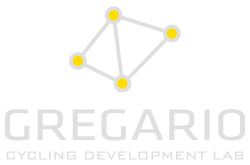Every successful ride is first and foremost a meditation activity.
Sooner or later along the way, we find ourselves entering a sort of trance: the lungs ventilate, the heart pumps, the muscle memory becomes automatic pilot: intensity, timing, coordination, reflexes. At this point, the brain has “only” to keep an eye on potholes and other road users (and that’s no small thing), but, considering the available computing power, it finds itself unemployed on average. Daily problems are suddenly summoned to a quick and decisive mental meeting: what can be solved is solved, what is not important is reduced, a sudden “lateral” gaze opens up on what seemed insoluble. The shower upon return consolidates the thoughts, fixes the fundamental ideas and we are ready to face new personal and professional challenges.
However, all this happens only on one condition: the absence of pain. Fatigue isn’t a problem, that’s part of the game, it’s wanted and desired by the cyclist, but pain is a whole other story, pain ruins everything. A knee that becomes inflamed, an insistent discomfort in the neck or an unexpected burning in the groin can compromise all the meditative pleasure. The brain can’t focus on anything else: “Maybe if I go back a little on the saddle… no, now I’ll try standing up… nothing to do, I’ll go back to gripping high… nothing, maybe a sprint will help to unlock, nope… what do I do? I know I have to go back.” Missed goals and consequent disappointment.
Then, maybe, you wait a few days, even a week and try again. And what a frustration when that pain makes itself felt again, perhaps even after a few kms in which it has left us harboring the illusion of a successful ride. Even in the hypothesis of lowering the pace and concluding the following rides without problems, the mental state is compromised: one spends the time listening to the nerves, registering every slightest signal, in fear of recognizing the beginning of that pain again.
In the worst case, you enter a loop of medical visits, bike-fitting sessions, saddle/handlebar/stem/riser/cleat/adjustment changes/etc. And in all of this we stop at a certain point to think: where is that pleasure of getting on our most faithful bike, taking the road and quickly entering that meditation bubble?
Anyone who has known this path knows that a custom frame represents the most effective and long-lasting solution. A custom frame is designed to adapt to the physical and morphological characteristics of the cyclist, ensuring optimal posture, balanced weight distribution and less pressure on the joints. Thanks to this customization, the risk of experiencing pain and injuries is drastically reduced, allowing you to fully enjoy every pedal stroke and to keep your mind focused on the essence of the journey. Investing in a custom frame is investing in your physical and mental well-being, rediscovering that meditation in motion that makes cycling one of the most rewarding and liberating experiences. Only in this way will the cyclist be able to rediscover the true meaning of that meditation bubble on two wheels, where the body, the mind and the road merge in perfect harmony.
